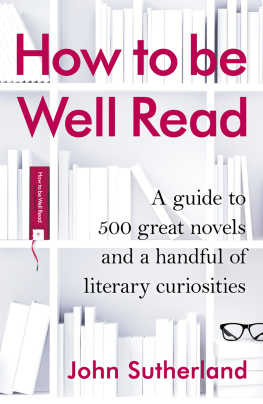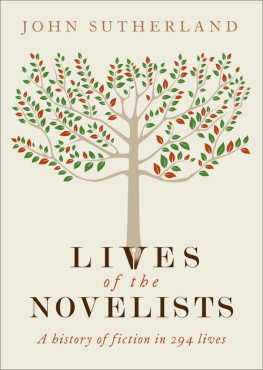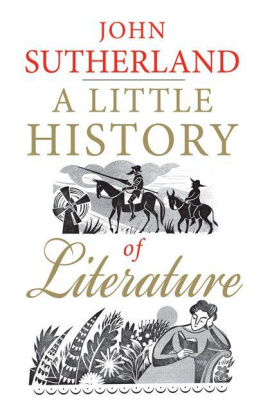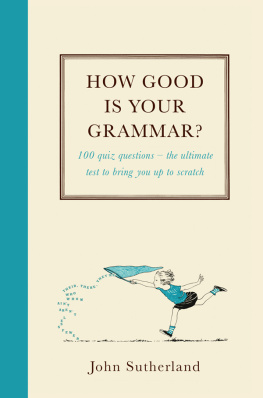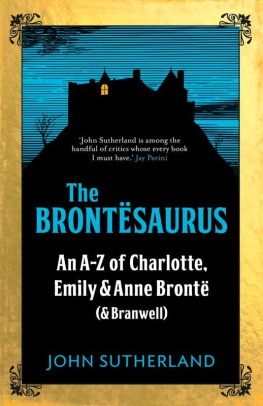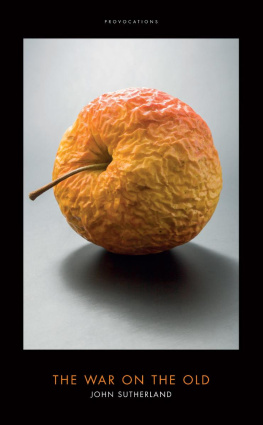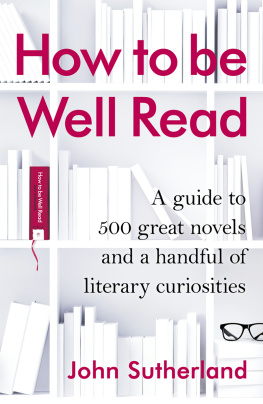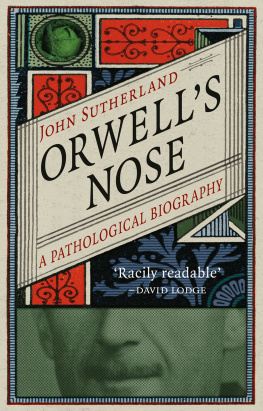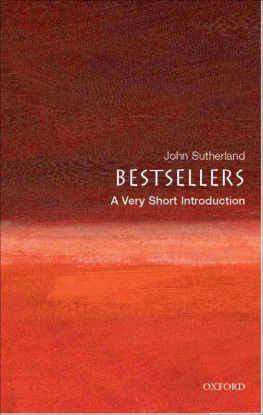John Sutherland - How to Read a Novel
Here you can read online John Sutherland - How to Read a Novel full text of the book (entire story) in english for free. Download pdf and epub, get meaning, cover and reviews about this ebook. publisher: St. Martins Publishing Group, genre: Art. Description of the work, (preface) as well as reviews are available. Best literature library LitArk.com created for fans of good reading and offers a wide selection of genres:
Romance novel
Science fiction
Adventure
Detective
Science
History
Home and family
Prose
Art
Politics
Computer
Non-fiction
Religion
Business
Children
Humor
Choose a favorite category and find really read worthwhile books. Enjoy immersion in the world of imagination, feel the emotions of the characters or learn something new for yourself, make an fascinating discovery.

- Book:How to Read a Novel
- Author:
- Publisher:St. Martins Publishing Group
- Genre:
- Rating:3 / 5
- Favourites:Add to favourites
- Your mark:
- 60
- 1
- 2
- 3
- 4
- 5
How to Read a Novel: summary, description and annotation
We offer to read an annotation, description, summary or preface (depends on what the author of the book "How to Read a Novel" wrote himself). If you haven't found the necessary information about the book — write in the comments, we will try to find it.
How to Read a Novel — read online for free the complete book (whole text) full work
Below is the text of the book, divided by pages. System saving the place of the last page read, allows you to conveniently read the book "How to Read a Novel" online for free, without having to search again every time where you left off. Put a bookmark, and you can go to the page where you finished reading at any time.
Font size:
Interval:
Bookmark:
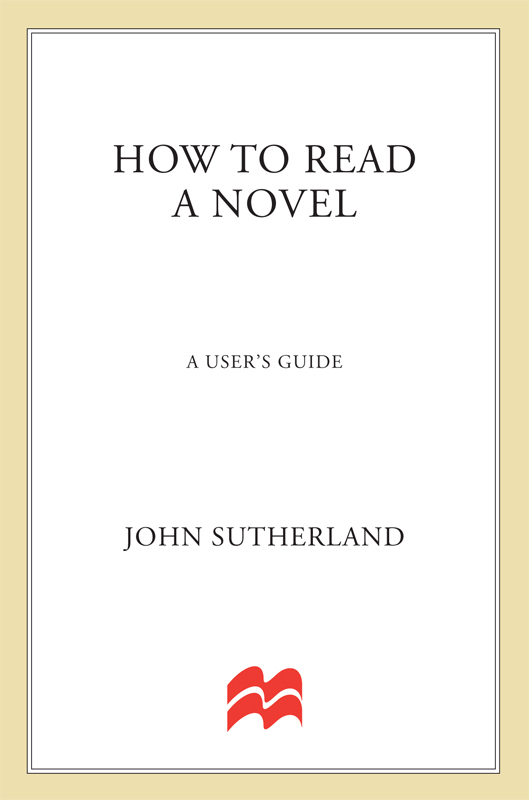

The author and publisher have provided this e-book to you for your personal use only. You may not make this e-book publicly available in any way. Copyright infringement is against the law. If you believe the copy of this e-book you are reading infringes on the authors copyright, please notify the publisher at: us.macmillanusa.com/piracy.
Contents
chapter 1
So many novels, so little time
AN ALTERNATIVE TITLE for this book might be Reading in an Age of Plenty or, more eye-catchingly, Reading through the Avalanche . In part its an autobiographical exercise. During my novel-reading lifetime (1943 to 2006 and still going) the national book supply has swollen from trickle to deluge, with the prospect of a veritable tsunami to come. Every week now more novels are published than Samuel Johnson had to deal with in a decade.
If you had the riches of Croesus (or Bill Gates) you could, with a few hours key-stroking, order up from Amazon.com some half-million novels to be Fedexed, rush delivery, in thirty-six hours. You would, of course, need a disused airplane hangar to keep the books in and a small army of forklifting stackers and fetchers to move the things. Given a reading career of fifty years, a 40-hour reading week, a 46-week working year and three hours per novel, you would, as I calculate, need 163 lifetimes to read them all. And very dull lifetimes they would be. More fun on the forklifts.
Ornithologists can, and do, observe with their own eyes up to 90 per cent of the globes 9,000 or so surviving birds, but no one in the twenty-first century is going to scrape away at more than a tiny fraction of the fiction that is on offer the fiction that is just a keystroke and a Fedex delivery away; or, if push comes to shove, a visit to the nearest copyright or major university library.
It is that condition of surplusage which is the raison dtre of this book about books. Targeting, archiving and reading techniques have necessarily evolved with the daunting amount of fiction-reading experience now on offer. And, as I have already stressed, the relative shortness of time in which the modern reader has to read. To have enjoyed Goncharov, Tolstoy, Dostoyevsky and Turgenev, V. S. Pritchett once mused, the Russian day must surely have been longer like those summertime White Nights in St Petersburg, when the sun barely sets. How else could the nineteenth-century Russian have done justice to the massiveness of War and Peace , Crime and Punishment , or Oblomov (itself, incidentally, a comic fantasia on vast tracts of time, with nothing to do but lie on a sofa and consume fiction and food)? Time must surely have ticked slower for Tolstoys contemporaries. Pritchett, a practitioner of exquisite short fiction, inhabited a more hurried world.
Russians of the reading classes indeed had enviable amenities notably more leisure time and more servants. And, in summer, the days were longer which spared candles and eyestrain. Most importantly, there were fewer novels to deal with. Anna Karenina, who read the congenially spacious Trollope on her journey from Moscow back to St Petersburg, had her first-class seat comfortably set up for her, with a special reading lamp, by her servant in a ladies only compartment. If she dropped her Trollope to the carriage floor, Annushka was there to pick the volume up for her (only twenty years earlier, it would have been a serf). The passage from Anna Karenina (18737) is worth quoting in its entirety for the sublimely languorous description of the Russian reading experience, AD 1870:
With the same preoccupied mind she had had all that day, Anna prepared with pleasure and great deliberation for the journey. With her deft little hands she unlocked her red bag, took out a small pillow which she placed against her knees, and locked the bag again; then she carefully wrapped up her feet and sat down comfortably. An invalid lady was already going to bed [this, remember, is a railway carriage]. Two other ladies began talking to Anna. One, a fat old woman, while wrapping up her feet, remarked upon the heating of the carriage. Anna said a few words in answer, but not foreseeing anything interesting from the conversation asked her maid to get out her reading lamp, fixed it to the arm of her seat, and took a paper knife and an English novel from her handbag. At first she could not read. For a while the bustle of people moving about disturbed her, and when the train had finally started it was impossible not to listen to the noises; then there was the snow, beating against the window on her left, to which it stuck, and the sight of the guard, who passed through the carriage closely wrapped up and covered with snow on one side; also the conversation about the awful snow-storm which was raging outside distracted her attention. And so it went on and on: the same jolting and knocking, the same beating of the snow on the window-pane, the same rapid changes from steaming heat to cold, and back again to heat, the gleam of the same faces through the semi-darkness, and the same voices, but at last Anna began to read and to follow what she read. Annushka was already dozing, her broad hands, with a hole in one of the gloves, holding the red bag on her lap. Anna read and understood, but it was unpleasant to read, that is to say, to follow the reflection of other peoples lives. She was too eager to live herself. When she read how the heroine of the novel nursed a sick man, she wanted to move about the sick room with noiseless footsteps; when she read of a member of Parliament making a speech, she wished to make that speech; when she read how Lady Mary rode to hounds, teased her sister-in-law, and astonished everybody by her boldness she wanted to do it herself. But there was nothing to be done, so she forced herself to read, while her little hand played with the smooth paper knife.
Picture Anna Karenina in her carriage the next time you ride a crowded, sweaty underground train or subway car, alongside some passenger cramming in a couple of pages of Danielle Steel, or John Grisham, before their stop. And it would be wiser, given recent terrorist outrages, not to start wielding your smooth paper knife in the carriage.
To be well read in Britain or America in 1906 was to have a good library, a good source of literary news (Lord Northcliffes new publication, The Times Literary Supplement , for example; or, for Americans, Harry Thurston Pecks the Bookman ), access to a good bookstore and friends in the know about what everyone was reading. And, of course, lots of time. It was manageable. A person could be well read and still have a life.
No longer. To be well read in 2006 requires non-traditional strategies and ruthless short cuts. When, as is now imminent, the whole of print goes on line, new, more drastic strategies will be required. In 2016, the ratio of fiction accessible to time available will be, frankly, mind-boggling. Mind rupturing might be the more accurate term. As reported in the Guardian , Bill Gates, on a stopover in the United Kingdom in October 2005, predicted that
the next challenge would be to take advantage of ubiquitous wireless, super-fast internet connections. Advances in computer hardware had been a miracle but high-speed internet connections would accelerate the pace of change even further. Computers would become almost invisible, he said, integrated into everything that we do. In some ways the computer just disappears into the environment. All these devices will be hooked up to the internet and the internet will not have any speed limitations. And these devices will be a lot cheaper than they are today, he said. Magazines and newspapers would eventually become redundant in their existing form, with interactive, personalised content delivered to handheld devices. A lot of the reading thats taking place, the richness to be able to call up anything will take over, he said. Mr Gates pointed to students as an example of how the world would shift from books to bytes. Within four or five years, instead of spending money on textbooks theyll spend a mere $400 or so buying that tablet device and the material they hook up to will all be on the wireless internet with animations, timelines and links to deep information. But theyll be spending less than they would have on text books and have a dramatically better experience.
Font size:
Interval:
Bookmark:
Similar books «How to Read a Novel»
Look at similar books to How to Read a Novel. We have selected literature similar in name and meaning in the hope of providing readers with more options to find new, interesting, not yet read works.
Discussion, reviews of the book How to Read a Novel and just readers' own opinions. Leave your comments, write what you think about the work, its meaning or the main characters. Specify what exactly you liked and what you didn't like, and why you think so.

